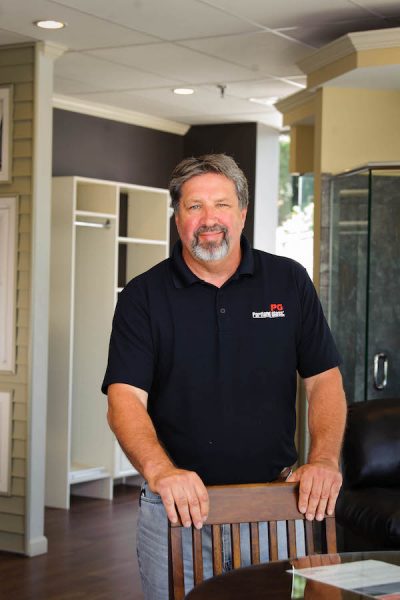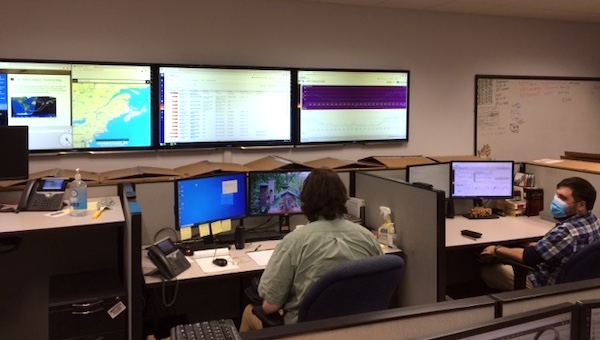
Bernie Forcier, who’s 62, has had diabetes for 30 years. Fortunately, he’s been able to keep it under control. He’s on insulin, has to watch his weight, exercise, and try to avoid stress — it’s a constant balancing act. He also has to have regular bloodwork and see his diabetes specialist every three months. These days, those provider visits are no longer in person. They’re Zoom calls. And so far, Bernie is just fine with that.
I was already familiar with Zoom, and I’ve used it three or four times since the start of COVID. It’s face to face, which is the next best thing to being in person.
Bernie Forcier, diabetes patient
It’s also much more convenient for him. He works at a glass company, which is considered an essential business and hasn’t missed a day since COVID hit (The company follows strict COVID protocols). He used to leave work to keep his diabetes appointments, but now he can stay at his desk.
I’m the manager of a store and I’m in and out a lot. Before COVID, when I had a doctor’s appointment, I’d get there, park, check-in, sit in the waiting room. The whole process could take an hour to an hour and a half. It now takes 15 to 20 minutes, so yes, the convenience factor is huge. Plus, you don’t have to wait next to somebody who might have COVID. When things get back to normal, whatever normal is, I would prefer this method.
Bernie Forcier
Bernie still has to go in person for bloodwork, but it’s usually a quick visit. He has to wear a mask and keep six-feet apart, something he’s always keenly aware of because diabetes puts him at risk if he gets COVID.
Seeing your health care provider online is known as telehealth. Telehealth has been around since long before COVID and according to Jasmine Bishop, who is Director of Telehealth at MaineHealth, it can mean many different things.

One of our strongest programs is Care at Home Visiting Nurses, which has been around for 20 years and does both video visits and monitoring. They can monitor patients remotely and if their various levels are not where they should be, can have an on-demand video visit. This program is only for certain patients who qualify for home health.
In the hospital setting, we have the Telestroke program in about eight different hospitals. If you go into a hospital exhibiting signs of a stroke and there is not a neurologist available, one of our lead neurologists can advise the local care team on whether or not to administer TPA, which is a blood clot breaking medicine. It can be a phone call or the neurologist may want to “see” the patient by video. That was our strongest hospital-based program prior to COVID. and still is.
In the ambulatory setting, a patient might go to their local primary care practice and see a specialist in Portland over video. We also use Telehealth in the school setting, mostly for speech therapy.
Jasmine Bishop, Director of TeleHealth, MaineHealth
Before COVID, MaineHealth’s telehealth programs had between 1500 and 2000 video visits a month. By May they were seeing more than 30,000 patients each month and now about 40,000 a month — a 2000% increase. The only way they could handle the surge and ramp up their resources quickly was to start using Zoom, which is a cloud-based video communications app. Jasmine says they did not use Zoom prior to COVID but found it easy to set up, and more importantly, that it offers a special security model for healthcare that is HIPAA compliant and follows certain privacy guidelines. For example, visits cannot be recorded and there are layers of encryption.
One of the biggest hurdles to providing teleHealth to many patients was that Medicare wouldn’t reimburse any in-home video visits. When COVID hit, the restrictions were temporarily lifted. Jasmine says having no restrictions has made a huge difference.
It allowed us to move our medical care from the clinic setting to the patient home setting. Here in Maine, we saw our first COVID case the day after the World Health Organization (WHO) declared the pandemic. Within a week, MaineHealth had launched telehealth to all of our primary care practices — over 50 primary care practices, in two weeks launched to all of our specialty practices, and then a week later to rehab and behavioral health. At this point, we have over 200 practices and 1200 providers.
Jasmine Bishop
Because of the increased demand, they’ve had to expand their telehealth teams, and are also expanding services that help support the video visits.
We’re going to expand our patient remote monitoring program. We’re focusing on high-risk populations and getting devices such as blood pressure monitors, pulse oximeters, digital scales, and thermometers into patients’ homes so they check their own vitals and report to their providers.
Jasmine Bishop
In June, the Federal Communications Commission (FCC) awarded MaineHealth $803,268 to help it expand its telehealth infrastructure and technology in response to the coronavirus pandemic. A portion of those funds will be used to buy new high-end telehealth carts and videoconferencing equipment that will enable more patients to have in-home video visits with their providers.
Now, obviously, you can’t use telehealth for all of your medical needs, but COVID has certainly proven that it’s possible to use it in ways that most people had never considered before. But when it’s safe to do so, will people who’ve gotten used to video chats with their doctors decide they’d rather go back to the way it was before? Not Bernie Forcier.
If it’s a consultation only, I think video is the way to go. If I can do it just about anybody can. I use my computer but can imagine using my phone at some point. The convenience of it and the zero risk of being next to somebody is huge.
Bernie Forcier
But what if you don’t have a great internet connection? That’s the case in many areas in Maine.
That’s top of mind for me — the concept of the digital divide. We’re excited about the expansion of telehealth, but we’re really concerned about the patients who don’t have broadband, who don’t have mobile devices, and so we’re working on it. We’ve applied for grants and we’re working hard to build up a patient device library and to offer broadband access.
Jasmine Bishop

Jim Rogers is also working hard to increase broadband access throughout New England. He is the CEO of HealthConnect Networks, a company that manages a consortium of more than 1000 hospitals and clinics, primarily in Maine, New Hampshire, and Vermont. The New England Telehealth Consortium was formed in 2006/2007 and since then has received over $40 million in federal money to create a network for all those hospitals. A secure and private network that allows them to offer telehealth services, supports other programs such as electronic health records and PACS, which stores x-rays and other images digitally, and gives them access to the internet.
We built this network for them, and my firm currently manages the network. At last count,1090 hospitals and clinics, mostly in Maine, New Hampshire, Vermont, are all interconnected. We transmit on an average day, about 650 terabits. Because of COVID, the telemedicine numbers have spiked. We’ve had days where we’ve actually transmitted over 1 1/2 petabits a day of information. One petabit equals 1000 terabits.
Jim Rogers, CEO, Health Connect Networks
To help put those numbers into perspective, Jim says if you stack one quadrillion (one petabit or 1000 terabits) sheets of paper on top of each other, the stack would be 68 million miles high. This is a lot of bits. He also explained the difference between bits and bytes.
Network traffic is typically measured in bits, the actual ones and zeros that travel through the network. There are 8 bits in one byte. One byte is equivalent to one letter or symbol (e.g. the letter A). Storage and memory aretypically measured in bytes.
Jim Rogers
There will not be a quiz.

Creating a powerful and secure network that allows hospitals and clinics to communicate with one another is vitally important, but if the whole idea behind telehealth is to connect providers and patients by video, then you need to provide those patients with internet access as well. That’s the next big project Jim has taken on. He created another company called Mission Broadband.
I would say that Maine is pretty bad as far as adequate Internet to the majority of the population. Their internet is nonexistent, isn’t good, they can’t get it, or they can’t afford it. All kinds of problems. In November of 2018, I had an epiphany moment. I could see a model for how every home in America could be on the internet using a public-private partnership model.
Jim Rogers
There are lots of ongoing efforts to increase broadband service but it’s a big challenge, especially in rural areas, which is much of Maine, and it’s expensive. Jim saw that many towns were struggling to solve the problem in their communities by building their own private networks. Under his epiphany model, instead of going it alone, towns could collaborate with private companies that provide internet services and together, apply for state and federal funding.
It’s a new company and so it’s a work in progress, but he was successful in building a network for hospitals and is equally determined to bring the internet to individuals so that, among other things, they can have a video visit with their healthcare provider without leaving the house.
Which brings me back to the question of if telehealth continues to expand and more people can access it on the internet, will providers and patients still be interested in the future? That depends, says Jasmine Bishop, on how easy it is for both parties.
There needs to be a lot of consumer and provider education so that they fully understand how much they can do over video. Communicating the value is going to be key. There are definitely portions of almost every practice that couldn’t be done over telehealth, but conversely, I would say every practice and every single specialty has something they can do over telehealth.
Jasmine Bishop
Jasmine says MaineHealth’s biggest success during COVID-19 is the number of patients who are still able to receive care even though practices have had to close or drastically reduce their visits. The biggest challenge is not knowing if Medicare reimbursements will continue for in-home video visits. Lifting restrictions permanently will require Congressional action.
Another challenge is making sure providers are well-versed in seeing their patients online instead of in-person. To that end, MaineHealth launched a simulation center training program where actors take on the role of patients so providers can test their telehealth skills.
It’s not just hardware and software. It’s teaching providers something they didn’t learn in medical school — how to have what we now call a good webside manner, how to understand what makes an appropriate visit that makes both sides feel comfortable.
Jasmine Bishop
But what is most important is that providers using telehealth are able to provide the best care possible for their patients and can make sure they get it in the right place at the right time.


Leave A Comment